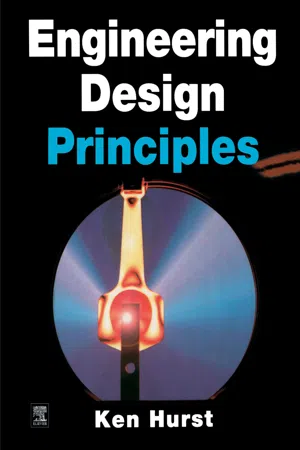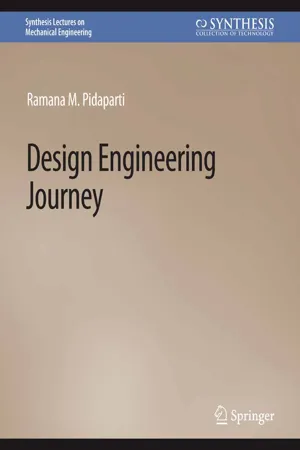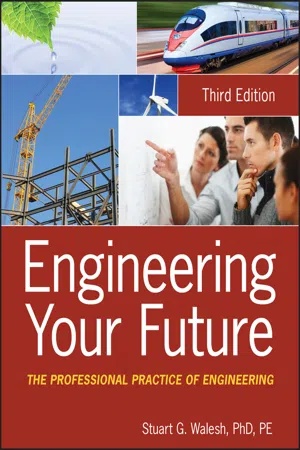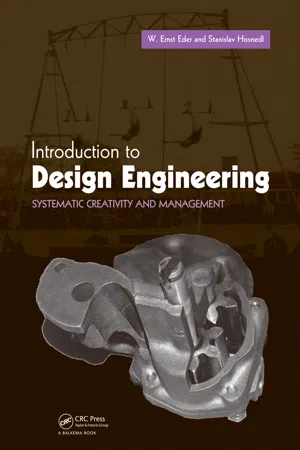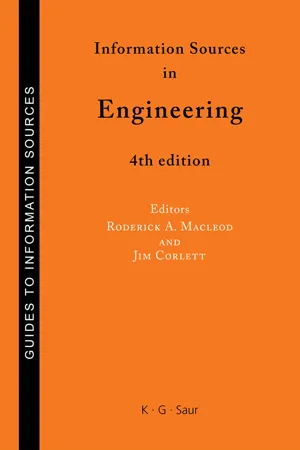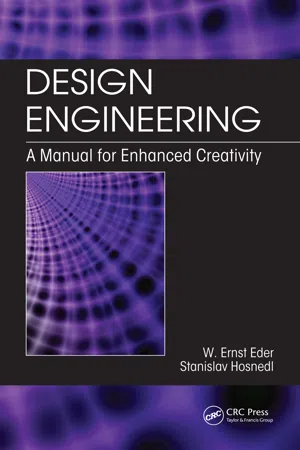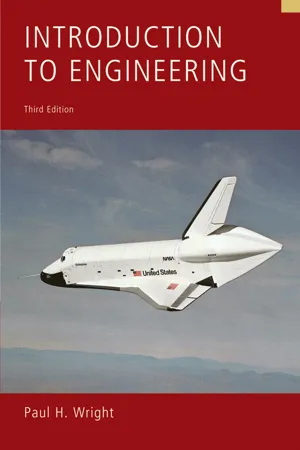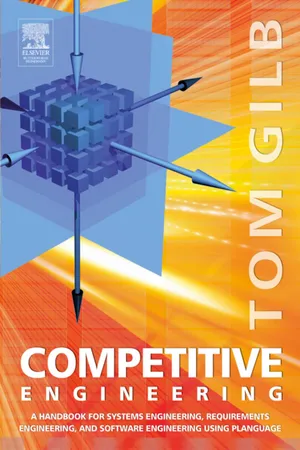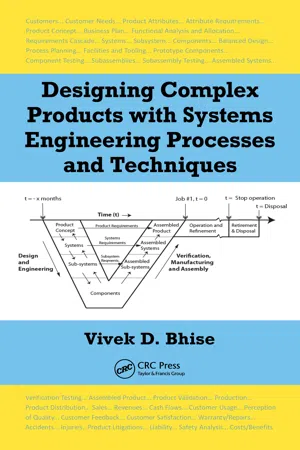Technology & Engineering
Design Engineering
Design engineering involves the application of scientific and engineering principles to the creation of products, systems, and processes. It encompasses the entire design process, from conceptualization and planning to prototyping and testing. Design engineers use their expertise to develop innovative solutions that meet specific requirements and address real-world challenges.
Written by Perlego with AI-assistance
Related key terms
1 of 5
12 Key excerpts on "Design Engineering"
- eBook - PDF
- Ken Hurst(Author)
- 1999(Publication Date)
- Butterworth-Heinemann(Publisher)
Having established that engineering design is a technology it is necessary to present a definition. Many attempts at a definition have been made, particularly in the search for a snappy, short definition, but all attempts to date have been defeated. The dictionary definition of design is often *to fashion after a plan', which tells us very little about the way of working that we call engineering design. What follows is an amalgam of definitions for both the process and practitioners taken from the UK based Institution of Engineering Designers and the engineering design lecturer organization, SEED Ltd (Sharing Experience in Engineering Design). Engineering design is the total activity necessary to establish and define solutions to problems not solved before, or new solutions to problems which have previously been solved in a different way. The engineering designer uses intellectual ability to apply scientific knowledge and ensures the product satisfies an agreed market need and product design specification whilst permitting manufacture by the optimum method. The design activity is not complete until the resulting product is in use providing an acceptable level of performance and with clearly identified methods of disposal. In order to increase our understanding of design it is helpful to extend this definition and to identify and highlight the main characteristics of engineering design: • Trans-disciplinary • Highly complex • Iterative. Introduction to engineering design I 5 1 Most engineering design is now a trans-disciplinary team effort and the distinctions between the traditional disciplines, mechanical, electrical, electronic, civil and even chemical engineers are becoming blurred. Relatively new areas of engineering specializa-tion, such as control and software engineering should be added to this list. Consider for example automobiles, which not so very long ago were the sole province of mechanical engineers. - eBook - PDF
- Ramana Pidaparti(Author)
- 2022(Publication Date)
- Springer(Publisher)
According to ABET, engineering design is defined as the process of devising a system, component, or process to meet desired needs. It is a decision-making process (often iter- ative), in which the basic sciences, mathematics, and engineering sciences are applied to convert resources optimally to meet a stated objective. 2 1. THE DESIGN JOURNEY Figure 1.1: Words defining the term “design.” Among the fundamental elements of the design process are establishment of objectives and criteria, synthesis, analysis, construction, testing, and evaluation. The engineering design component of a curriculum must include at least some of the following features: development of student creativity, use of open-ended problems, development and use of design methodol- ogy, formulation of design problem statements and specifications, consideration of alternative solutions, feasibility considerations, and detailed system descriptions. Further, it is essential to include a variety of realistic constraints such as economic factors, safety, reliability, aesthetics, and social impacts. 1.3 WHAT IS ENGINEERING/PRODUCT DESIGN? Engineering design is a scientific decision-making process used to meet specific societal needs such as construction of physical objects (aircraft, engines, bridges, medical devices, chemical plants, skyscrapers) or information systems (computer software, chips). The overall objective of any engineering design is to create a product/process/system that benefits society and also at the same time turns into an economic benefit. The ability to design is both a science as well as an art, and combines analysis and synthesis methods. The scientific aspects of design can be learned through a systematic process (design methodology), problem-solving techniques, and through experiential learning. The artistic as- 1.4. DESIGN EXAMPLES 3 pect of the design is gained through practice, by developing the ability to appeal to the aesthetic as well as technical design specifications. - eBook - PDF
Engineering Problem Solving
A Classical Perspective
- Milton C. Shaw(Author)
- 2001(Publication Date)
- William Andrew(Publisher)
Engineering Design 305 305 1.0 INTRODUCTION Design has many meanings to different people. These include the conception of a new process, a new product, a new use of a physical effect, the preparation of detailed drawings or tools for the workshop, a manufac-turing plan, or even a marketing strategy. Design is involved in essentially all engineering activities. Also, the elements of creativity and innovation are involved in all types and levels of design whether it is design for improved reliability and functional life, improved esthetics, reduced cost, improved ergonomics, or manufacturing methods. Design is a very important engineering activity. It involves meeting some need by applying the laws of physics and chemistry, using mathemat-ics, and the computer where appropriate. Steps in the design process involve some or all of the following: 1. Identifying requirements of the device to be designed. 2. Devising as many general solutions as possible. 3. Comparing possible approaches and selecting the one which appears to be most promising. 4. Performing detailed design based on the selected approach. 5. Specifying shapes, materials, tolerances, standard parts, methods of manufacture, and methods of testing and evaluation. 12 Engineering Design 306 Engineering Problem Solving: A Classical Perspective 6. Building a prototype and testing. 7. Redesigning to take care of problems uncovered, optimizing. 8. Adjusting the design for manufacture, taking into account cost, availability of materials and processes, ease of assembly and maintenance, useful life, appearance (esthetics), service life, safety and consequences of failure, energy consumption, and impact on the environment. 9. Sales and application procedures. 10. Updating the design based on performance in the field. While all steps in the design process involve creativity, it is particu-larly true for the initial steps where the basic concept of the design is established. - eBook - PDF
Engineering Your Future
The Professional Practice of Engineering
- Stuart G. Walesh(Author)
- 2012(Publication Date)
- Wiley(Publisher)
While the process typically relies heavily on traditional means and methods, it may include innovative and creative approaches. The goal of design is quality, that is, meeting all requirements as discussed in the previous chapter. 269 Informed by this broad definition of design, recognize that various engineering disciplines offer definitions tailored to their specialties. For example, civil engineer Choi (2004) defines design as “a multidisciplinary process involving detailed analysis, judgment, and experience aimed at producing construction drawings, technical spe- cifications, and bid schedules required to allow contractors to bid and construct physical projects.” Mechanical engineers Ulrich and Eppinger (2008) describe “design for manufacturing” (DFM) as consisting of estimating the manufacturing cost, reducing the cost of components, reducing the cost of assembly, reducing the cost of supporting production, and considering the impact of the decisions on other factors such as overall development time and the life-cycle cost of the designed item. The ultimate result of the design process – the fruit that grows from the root – is a useful structure, facility, system, product, or process. Aeronautical engineers design aircraft and spacecraft, civil engineers design high-speed rail systems, chemical engi- neers design processes to convert raw materials into finished products, and mechanical engineers design hybrid automobiles. As a result of their design orientation, all engi- neering disciplines deliver functional results some of which are stunning and widely acknowledged while others are unnoticed or taken for granted. Essentially all engi- neering designs contribute to the quality of life for untold users. Mathematics, natural sciences, humanities, and social sciences are the foundation of engineering, as explicitly described, for example, in the U.S. - eBook - PDF
Introduction to Design Engineering
Systematic Creativity and Management
- W. Ernst Eder, Stanislav Hosnedl(Authors)
- 2010(Publication Date)
- CRC Press(Publisher)
Even though methods may not be recognizable, designing can be methodi-cal and systematic, includes creative thinking, clarifying thinking, critical thinking, and other forms. Designing uses existing information, including scientific and other Context of Design Engineering 5 knowledge. The information for designing lies predominantly in the collection of existing areas of knowledge and knowing. Design Engineering involves some skills and abilities, and their realization in craft. Society and individuals have many needs and wishes. These are manifested in the tasks of organizing their lives, establishing a livelihood, avoiding hunger, obtaining security, trying to improve the quality of life , etc., compare figure 2.2. Needs and wishes also arise as a result of establishing a society, interrelationships, infrastructure, trade, communication, social and political administration, housing, industry, agriculture, recreation, transportation, power, community services, laws, culture, community, etc. A need implies that a suitable product is not available, something must be (artifi-cially) transformed from an existing state into a different state to satisfy the need. Any changes demand that technology (no article) must be applied, and that values are created. Science, engineering and technology cannot be value-free [27, 407, 408, 420]. Values are interdependent with society and products in a complex way, see figure 1.2, part A, resulting in needs, requirements, wishes, desires, visions, dreams – different levels of demand for satisfaction – but also restrictions and constraints. Some of these relationships are supporting, others may lead to conflicting requirements or results. Added functionality always costs something, may conflict with safety [11] and/or efficiency, or have ergonomic, esthetic, economic, ecological and other consequences. These relationships must be evaluated for specific cases and situations. Figure 1.2, Figure 1.1 Characteristics of designing [153]. - eBook - PDF
Engineering Design Graphics
Sketching, Modeling, and Visualization
- James M. Leake, Molly Hathaway Goldstein, Jacob L. Borgerson(Authors)
- 2022(Publication Date)
- Wiley(Publisher)
For instance, it is a process, one that prominently involves both problem-solving and decision-making activities. Engineering design also employs both analysis and synthesis. By nature it is interdisciplinary and iterative. Even prior to the emergence of such modern concepts as concurrent engineering and the design team, there has always been a strong social aspect to engineering design. Finally, in keeping with the main topic of this book, engineering design is characterized by strong graphical elements. Engineering design is really about solving problems. In fact, a simple definition of engi- neering design is “a structured problem-solving approach.” 2 Concisely described, the design process is no more than identifying a problem, carefully researching and defining the problem in order to better understand it, creatively gener- ating possible alternative solutions to address the problem, evaluating these candidate solutions ENGINEERING DESIGN 1 Rudolph J. Eggert, Engineering Design, Pearson Prentice Hall, 2005. 2 Arvid Eide et al., Engineering Fundamentals and Problem Solving, McGraw-Hill, 1997. CHAPTER 1 ENGINEERING DESIGN 2 to ensure their feasibility, making a rational decision, and then implementing it. One of the hidden merits of an engineering education is that this problem-solving framework becomes so ingrained that it can easily be adapted to deal with life’s many problems, technical or otherwise. Although the need to make decisions is apparent throughout the course of a design’s evo- lution, decision making in conjunction with engi- neering design typically refers to that part of the design process where competing feasible solutions are evaluated and an optimal solution is decided upon. Because of the numerous tradeoffs involved, these types of decisions are often difficult to make. Examples of such tradeoffs include strength versus weight, cost versus performance, and tow- ing power versus free-running speed. - eBook - PDF
- Mike Tooley, Lloyd Dingle(Authors)
- 2010(Publication Date)
- Routledge(Publisher)
641 BTEC National Engineering. DOI: Copyright © 2010 Mike Tooley and Lloyd Dingle. Published by Elsevier Ltd. All rights reserved. 10.1016/B978-0-12-382202-4.00008-8 Engineering Design D esign is the process of converting an idea or market need into the detailed information necessary to manufacture a product or deliver a service. Successful design involves combining a number of skills together with the use of available technologies, materials and processes and then being able to deliver the product or service at a cost that will make it competitive with other products and services. Being able to design something is a fundamental engineering skill but simply being able to design something is not the end of the story. Equally important are the skills that you will need in order to be able to communicate your design to other people; even the most basic design will be hopelessly flawed if you cannot explain to people what it is about and how to make it! As an engineer, you might be involved with the design of an engineered product that varies from something as basic as a screwdriver to something as complex and sophisticated as a military aircraft. This unit will help you understand the design process and provide you with a variety of skills that will help you communicate your ideas to other people. Unit 8 Engineering Design 642 UNIT 8 The Design Process The design process is the name given to the various stages that we go through when we design something. Each stage in the process follows the one that goes before it and each stage is associated with a particular phase in a design project. You also need to be aware that design is not always about creating a brand-new product or service. Instead, it is often about improving or modifying an existing product. - eBook - PDF
- Roderick A. Macleod, Jim Corlett, Roderick A. Macleod, Jim Corlett(Authors)
- 2012(Publication Date)
- De Gruyter Saur(Publisher)
Engineering Design Steve J. Culley and Chris A. McMahon • I N T R O D U C T I O N The engineering design process is the process by which a need for an arte-fact is translated into a description of the artefact for manufacture, and as such is a vitally important activity. It is the means by which a company turns what it has learned about its product domains and its markets into products for sale. Holmes (1999) notes that the quality and performance of these products is paramount in determining the success of the company, and thus investment in the product design process can be among the most cost-effective investments that any firm can make. Key to the performance of the design process, and thus a central factor in this investment, is effec-tive information provision to the process. Design can be one of the most difficult collaborative activities under-taken by people. For complex products such as aircraft or automobiles, the design process may involve thousands of participants in different companies distributed over many geographic locations and working over many years. The quality and performance of today's products comes in many cases from the detailed effort that can be applied by distributing the work over a large team. In such a process, the communication and sharing of knowledge and information among the participants are very important issues. Today, design teams work under increasing pressure to develop prod-ucts of high performance and reliability at low cost and in shorter and shorter time-scales. Increasingly, design responsibilities for complex assem-bles are devolved to the suppliers of the sub-assemblies and parts that make up the assembly, and these suppliers may be located anywhere in the world. Design is also increasingly interdisciplinary in nature. - eBook - PDF
Design Engineering
A Manual for Enhanced Creativity
- W. Ernst Eder, Stanislav Hosnedl(Authors)
- 2007(Publication Date)
- CRC Press(Publisher)
One of the tasks of EDS is to explore the reasoning patterns needed by designers, how to use them and how to safeguard them from errors. This safeguarding function is in part performed by engineering design methodology, and the engineering design methods. 12.2 SYSTEM A first discussion may be found in Section I.6. Defining a terminology is not popular, choosing suitable technical terms is difficult, and reading definitions is usually res-isted. This step is unavoidable to reduce misunderstandings. Criticisms come easily from people who have chosen a different term to express a similar content. This can be avoided if the opinions are confronted and discussed, and unity can be reached. A tradition exists of intuitively accepting and retaining some terms, or coining new terms from analogies, almost without questioning, and without exact definition. For example, the terms “machine” and “engine” have differing content— for example, “engine” can be a motor for automotive machinery, a device for regular scribed scale rulings, a search program for computer information retrieval, or other items. Some terms are only used in one scientific field, for example, buckling resis-tance. Other terms are used in normal language, and have imprecise or multiple interpretations. In a technical or scientific field, they are either used with a defined content, for example, system, tension, or have different meaning, for example, sleeve, 526 Design Engineering: A Manual for Enhanced Creativity bush, tooth, ram. The difficulties are increased by different meanings in other languages. The selection of technical terms for this book was based on the following principles. 1. Use of existing expressions in their conventional meaning, but more precisely defined. 2. Connections with general and engineering sciences, including mathematics. 3. Use of an international set of words to help attain international understanding. 4. Consistent use of the same word for the same meaning. - eBook - PDF
- Paul H. Wright(Author)
- 2012(Publication Date)
- Wiley(Publisher)
2.12 FUNCTIONS OF ENGINEERING Within a given engineering field of specialization, there is a wide range of functions or activities in which engineers may be involved (8). Engineers can be involved in some combination of these functions, and, conceivably, could perform all of them over the course of a career. These functions include: research, development, design, production, construction, operations, sales, and management. 1. Research involves seeking new knowledge or a better understanding of the significance and relationship of facts already known. 2. Development involves making the discoveries and results of research available in the form of useful products, methods, or processes. 3. Design is the process of converting concepts and information into detailed plans and specifications from which a finished product or facility can be manufactured or constructed. 4. Production is the industrial process by which products or articles are manufactured from raw materials. 5. Construction is the process of translating designs and materials into struc- tures and facilities such as buildings, highways, and power and communi- cation facilities. 6. Operations in engineering means the application of engineering principles or the performance of practical work. In manufacturing, operations involve procuring supplies, maintaining plant, and directing personnel. Engineers are prominently involved in the operations of utility companies, railroads, communications companies, and traffic control systems for large cities. 7. Sales in technological industries often requires the services of trained engineers to recommend the machines, tools, parts, or services to best serve the customers’ needs. 8. Management positions in many industries are occupied by engineers. They are responsible for the solution of problems of policy, finance, organiza- tion, public relations, and sales. - eBook - PDF
Competitive Engineering
A Handbook For Systems Engineering, Requirements Engineering, and Software Engineering Using Planguage
- Tom Gilb(Author)
- 2005(Publication Date)
- Butterworth-Heinemann(Publisher)
7.10 Summary: The Design Engineering Process The ‘Design Engineering process’ is a systematic, rational process of finding design specifications, which when implemented will satisfy a balanced set of requirements on time. The term ‘Design Engineering’ means a design process based on multi-dimensional quantified requirements and multiple quantified design attributes. It requires concurrent use of an implementation process, like Evo, based on quantified measurement of performance and costs at frequent evolutionary cycles, and of necessary analysis and correc-tion to maintain progress towards (potentially adjusted or traded off) formal and quantified targets. The selection of design ideas is determined by the need to deliver a set of specified stakeholder target levels within a set of specified constraint levels. The Design Engineering process is really concerned with identifying optional design ideas and evaluating the alternative possibilities to find Percentage Uncertainty : < Convert Scale Uncertainty to Percentage Uncertainty deviations > . Evidence : < Give the observed numeric values, dates, places and other relevant information where you have data about previous experience of using this design idea > . Source : < Give the person or written source of your evidence > . Credibility : < Credibility 0.0 low to 1.0 high. Rate the credibility of your estimates, based on the evidence and its source > . ======================= Priority and Risk Management ====================== Rationale : < Justify why this design idea exists > . Value : < Name [stakeholder, scalar impacts and other related conditions]: Describe or quantify the knock-on value for stakeholders of the design impacts > . Assumptions : < Any assumptions that have been made > . Dependencies : < State any dependencies for this design idea > . Risks : < Name or refer to tags of any factors, which could threaten your estimated impacts > . - No longer available |Learn more
- Vivek D. Bhise(Author)
- 2013(Publication Date)
- CRC Press(Publisher)
21 2 Systems Engineering and Other Disciplines in Product Design INTRODUCTION The emphasis in this book is on products that are designed, made, and used by people Thus, these products must be developed to satisfy certain needs of people Some products are very complex and Systems Engineering (SE) can help greatly during their life cycle phases The complexity in a product can be directly related to a number of systems contained in the product; number of subsystems in each of the systems; number of components in each of the subsystems; and number of interfaces between different components, subsystems, and systems The development process of complex products can be made more effective through a systematic implementa-tion of the SE processes and application of a number of its techniques The objective of this chapter is to provide a deeper understanding of the SE, its approach, processes, issues, techniques, advantages, and disadvantages In this chap-ter, we will develop the basic understanding into the SE and the product development processes by defining many terms and considerations used in the implementation of the processes We would also look at the other disciplines that are closely associ-ated to the SE such as Quality Engineering, Human Factors Engineering, and Safety Engineering SYSTEMS ENGINEERING FUNDAMENTALS W HAT I S S YSTEMS E NGINEERING ? Systems Engineering is a multidisciplinary engineering decision-making process involved in designing and using systems and products The SE activities involve both the technical and management activities from an early design stage to the end of the life cycle of a product, or a system (ie, when the product is removed from service and disposed off) The SE begins with the understanding of a customer’s needs and the development of an acceptable concept of the product (or system) The SE is also a multidisciplinary approach, that
Index pages curate the most relevant extracts from our library of academic textbooks. They’ve been created using an in-house natural language model (NLM), each adding context and meaning to key research topics.
